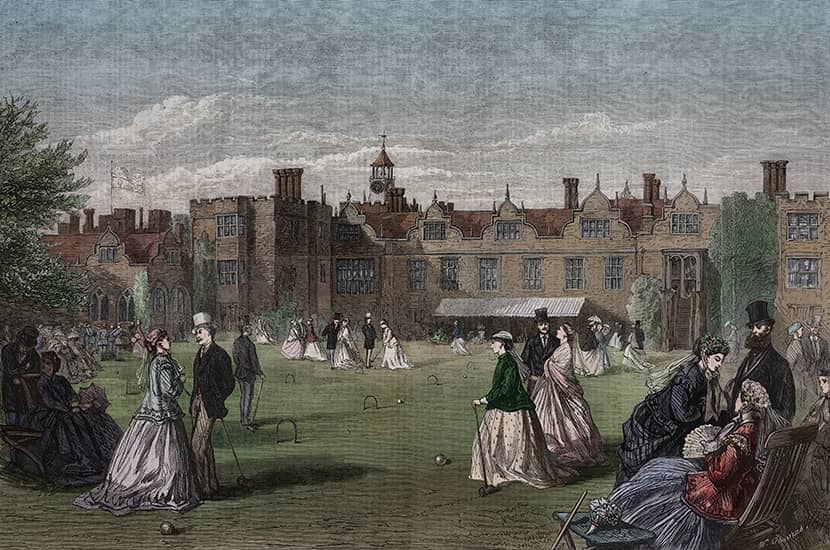The true English disease is Downton Syndrome. Symptoms include a yearning for a past of chivalry, grandeur and unambiguously stratified social order, where Johnny Foreigner had no place unless perhaps as butler in the pantry or mistress in the bedroom. And the focus of the disease is the country house, Britain’s best contribution to the world history of architecture. Except often the architect was Johnny Foreigner.
The typologies are well understood: from great halls with their Tudor feasts to Italianate palazzi, with Alexander Pope scribbling in the garden; thence to disturbing Victorian horrors corrupting their inhabitants (q.v. Balmoral), lovable Arts & Crafts by Lutyens and, latterly, the wince-making middle-brow pastiches of Quinlan Terry (whose clients include Michael Heseltine and Nicholas Coleridge).
The first thing to understand about the country house is that we love the past because it is safer there: ‘Our dates are brief and therefore we admire/What thou dost foist upon us that is old.’ Something in contemporary Britain makes this very poignant.
The second thing is a country house is not simply a house in the country. That would be to misunderstand the fine gradations of snobbery that are Britain’s greatest art form. Instead, as Clive Aslet explains in his genial new book, it is ‘a work of domestic architecture in a rural location, surrounded by its own land… intended to seem a self-contained unit’. In other words, a quasi-feudal private property.
Although he does not dodge the issue that we are in the territory of rich white men whose wealth often derived from sources which today require discussion, Aslet, a long-time editor of Country Life — whose original offices were designed by Lutyens — leans towards a good-natured narrative rather than a withering critique. He is a distinguished scholar, but never takes himself too seriously and is quick to see the funny side of things. Reading this book is like being in the company of a National Trust volunteer with a Cambridge education, a ripe collection of anecdotes and a bibliography all his own.
Literature has treated the country house generously. Ben Jonson wrote a poem about Penshurst in Kent. P.G. Wodehouse enjoyed crackling logs, shaded lights, the scent of buttered toast and a general atmosphere of leisured cosiness. Harold Nicolson described this too. These were the things Henry James missed most when in America. But country house enthusiasts appreciate access to a particular and privileged social milieu as much as they engage in any acute analysis of building design. You could call it Betjemanitis.
The crisis after 1945, with the milordi on their uppers and properties either in ruins or ruinous to maintain, revealed many tensions. Lionel Esher, the chairman of the Historic Buildings Committee of the National Trust, wrote in 1948: ‘And in the new world when cars and petrol are plentiful once more, here are the beautiful objectives of our summer holidays proudly waiting to be loved and understood.’ This patrician populism, magnificently tone-deaf to our ears, led to bouncy castles at Knole.
In other words, we progressed by looking backwards. There is, indeed, a small history of post-war country houses, but it is thin stuff, even if it obsesses fogeys such as Fitz-alan Pursuivant Extraordinary, otherwise known as John Martin Robinson, who has written at length on the subject.
Modernist examples are rare but include the Duke of Westminster’s Eaton Hall in Cheshire and the racing driver Sir Gawaine Baillie’s house in Warninglid in Sussex, both from the 1970s; but the last Duke did not like the former and recently had it resurfaced, while no one ever much cared for the latter.
Aslet, while always a lively leader around Holkham Hall, Blenheim and The Vyne, is also occasionally lazy. ‘The greatest architect of the age was Christopher Wren’ is not a sentence we ever need to read. He can also be a wee bit camp. Wondering about the difficulty of finding servants nowadays, he asks: ‘Who will polish the silver?’ But I hope this is self-mockery.
We are infatuated by the ruins of national memory, a trait that has enriched Julian Fellowes. Country houses produce what Disraeli called a ‘soul-subduing sentiment’. And he knew whereof he spoke, living in Hughenden, an ugly Victorian pile near High Wycombe. The National Trust has now commodified all of this into a jumble of politically correct, uneducated nostalgia, inviting us to have ‘fun’ at Hughenden — surely a misreading of what the Trust would call lived experience. Instead, as the historian Linda Colley explained, the fact that millions of visitors regard the country house as their heritage shows how very adroit British elites were at repositioning themselves in turbulent times.
The Story of the Country House, while based on impressive knowledge and experience, is neither a formal academic study nor a practical gazetteer. Its virtue is to encourage the reader to stop fretting about theoretical difficulties and enjoy a good story well told in amiable company — preferably in front of crackling logs with a pile of Country Life magazines resting on a faded chintz ottoman. It’s because the country house is dead that we love it so.






Comments